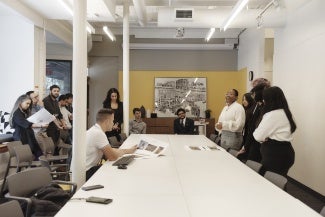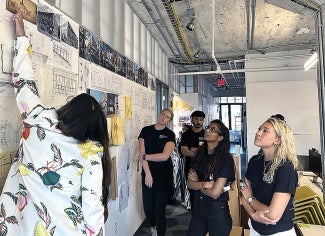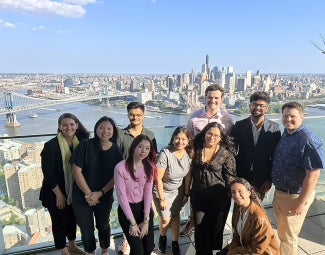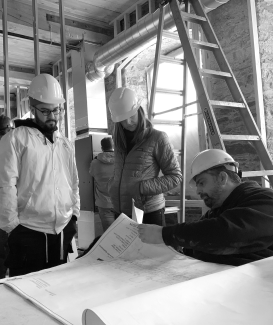
Redesigning the rules of early practice
How embedding equity frameworks upstream is helping to rewire architectural education.
What if architecture students entered the profession already fluent in intercultural competency, mentorship, and workplace culture?
At the Boston Architectural College, an innovative program is doing just that—making cultural fluency as foundational as design thinking or technical skills, using the AIA Guides for Equitable Practice as its framework.
The architecture profession has long struggled to retain women and designers of color. According to the 2024 NCARB By the Numbers report, women make up just 27% of licensed architects in the U.S., and people of color only 19%. These disparities stem from early barriers to access and networks, coupled with organizational practices that haven’t kept pace with a diverse workforce. McKinsey's Race in the Workplace and Women in the Workplace reports echo this trend, showing how many industries often address inclusion reactively—only after attrition, the “broken rung,” becomes visible.
Now, with NCARB's Competency Standard taking effect in October 2025, the profession faces a paradigm shift. The new standard outlines 16 core competencies and could open flexible licensure pathways—including options that bypass a NAAB-accredited degree. This shift prioritizes demonstrated ability over seat time and aims to make licensure more accessible and inclusive.
The challenge: How do we embed equity in this evolving landscape? What if equity-minded practice were integrated into students’ earliest professional experiences?
Embedding equity through early access to diverse practices
At the BAC, these questions aren't theoretical. As the recipient of the 2025 AIA/ASCA Practice and Leadership Award, the institution has long embraced adaptive, diverse practices and competency-focused innovation. This experience begins even before classes start: new student orientation includes firm visits where students meet practicing architects and connect with emerging professionals.
In 2022, the BAC launched Practice ConnEx (PCX), a semesterly externship that places students in diverse practice settings during the week before classes. PCX goes beyond job shadowing: it layers equity frameworks into the experience using daily readings from the Guides for Equitable Practice. Each day, students reflect on themes like intercultural competence, mentorship, and workplace culture, and share insights on a public blog, creating a living archive of emerging voices and fresh perspectives.
One undergraduate reflected on their experience at Safdie Architects:
"The diversity of our mentors highlighted how multiple perspectives contributed to the firm. They were patient, open to questions, [and] honest about their knowledge. It really showed that being a mentee didn't mean only having to learn from one person."
These reflections aren't abstract. They arise directly from what students witness in practice—far earlier than conventional curricula.
Another undergraduate student described Prellwitz Chilinski Associates:
"Their Feed-forward program [structures how] advice and feedback should be met with open-mindedness and empathy. A healthy workplace allows room for constructive criticism and shared discussions. Regular check-ins ensure team members can consistently improve."
These approaches plant seeds of mentorship and inclusive workplace culture from day one. The result: students develop cultural fluency as a professional competency. They ask critical questions: Who is included in decision-making? How does firm culture influence retention? What does equitable mentorship look like in action?
By reframing preparation as equity-minded observation and reflection, the BAC equips students to engage critically—not as passive participants but as active shapers of practice.
The BAC’s roots in practice-integrated education run deep. Founded in 1889 as the Boston Architectural Club, it was created by apprentices and draftsmen seeking collective advancement at a time when architectural education was largely limited to those with wealth or access to elite institutions like l'École des Beaux-Arts.
By day, students worked in architecture offices; by night, they gathered to sketch, critique, and study—democratizing education long before it became a national conversation. Robert Swain Peabody, one of the BAC’s founders, later became the AIA’s 8th National President—following Daniel Burnham and preceding Charles McKim. The BAC and AIA were closely linked in these formative years and for decades after, sharing a vision and financial commitment for teaching and mentorship, with leaders moving between institutions to strengthen a culture of professional development.
Over time, the BAC expanded access—welcoming women in the 1930s and pioneering the world’s first NAAB-accredited online architecture degree in 2009. Today, BAC graduates are 55% women and 39% students of color, compared to national figures of 27% and 19%. With nearly 20 BAC graduates completing NCARB’s Integrated Path to Architectural Licensure—eight times more than any other school—the college demonstrates how intentional integration of education and practice can shift the demographics of the profession.
Lessons for schools and firms: Embedding equity as a core competency
Treat cultural fluency like technical fluency.
Students trained to recognize mentorship dynamics and organizational culture bring those insights into teams, internships, and leadership roles. As firms navigate retention challenges and strive to create inclusive workplaces, graduates with reflective habits and a language for equity become indispensable.
Create feedback loops.
Structured reflection and public-facing testimonies provide firms with real-time insights into how their culture is perceived by emerging professionals—creating opportunities for organizations to assess and adapt their practices with fresh perspectives.
Embed equity in action, not policy.
The AIA Guides for Equitable Practice are most powerful when used as conversation starters in live contexts, not as static reading assignments. The “Act” section of the Guides provides clear next steps for individuals, firms, and the profession writ large. Practice ConnEx is one way to “create opportunities for authentic relationship building across a variety of identities,” integrating the Guides directly into students’ professional formation.
Shifting the starting line.
This isn’t just about preparing students—it’s about preparing the profession. As architecture enters a competency-based era, programs like the BAC’s New Student Orientation firm visits and Practice ConnEx show what’s possible when equity frameworks are embedded upstream.
At the BAC, 98% of architecture graduates are employed at graduation, and 46% already hold management roles. Tomorrow’s architects will face challenges we can’t yet predict. But we can prepare them with technical skill, cultural awareness, and ethical discernment.
Cultural fluency is no longer optional—it’s a core competency for architects leading in a pluralistic world. Shift the starting line, and you shift the trajectory. Equity and excellence don’t compete—they grow together from the very beginning.
Bethany I. Lundell Garver, AIA, NOMA, is Dean and Faculty of Practice and Director of Gateway Office at the Boston Architectural College.






